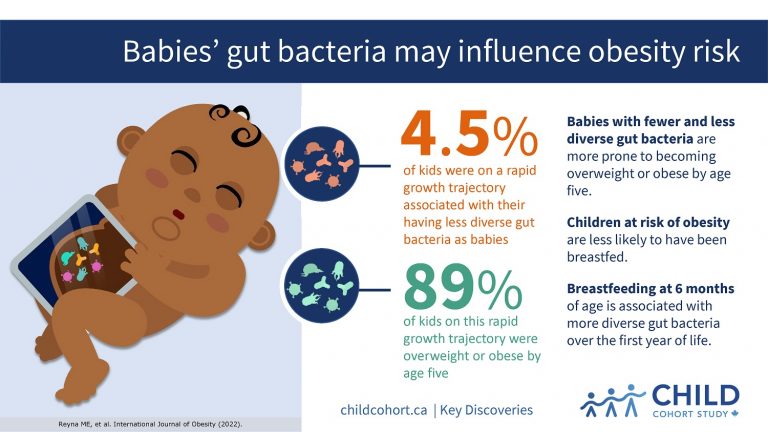Babies’ gut bacteria may influence obesity risk
A study of over 3,000 Canadian kids has shown that the bacteria in a baby’s gut in the first year of life may influence the child’s growth pattern from as early as infancy and up to school age.
The study, published in International Journal of Obesity, found that a lower diversity of gut bacteria during a baby’s first year is associated with a steep increase in body mass index (BMI) that can lead to obesity later on.
“Knowing that the gut microbiome is a key regulator of metabolism and weight,” explains co-first-author Myrtha Reyna-Vargas, a biostatistician at The Hospital for Sick Children, “we wanted to understand how shifts in the early -life microbiota relate to rapid growth or obesity, and how this in turn may be influenced by certain factors in a baby’s environment.”
Using data from over 3,000 children participating in the CHILD Cohort Study, the researchers calculated body mass index z-scores (BMIz) for the children, incorporating weight according to age and sex.
RAPID GROWTH LINKED TO OBESITY, MICROBIOTA
They identified four types of BMIz growth trajectories:
• Low stable growth (9.4% of children)
• Normative growth (60% of children)
• High stable growth (35.5% of children)
• Rapid growth (4.5% children)
“Over 70% of the children in the rapid growth trajectory were overweight or obese by age three, and 89% were overweight or obese by age five,” says Reyna-Vargas.
The researchers also analyzed the bacteria in stool samples taken from the infants at three-to-four months and at 12 months of age.
They found that infants in the rapid growth trajectory gained significantly less diversity in their gut microbiota during the first year of life and displayed an altered microbiota composition by one year when compared to normative growth infants.
“In other words, the children with obesity tended to have fewer types and a lower abundance of certain bacteria in their gut,” adds co-first-author Dr. Charisse Petersen, a Research Associate at The University of British Columbia.
“In particular, we noticed that lower levels of a bacteria called Akkermansia seemed to be associated with weight gain and higher BMIz scores.”
BREASTFEEDING IS GOOD FOR THE GUT
The study found that infants in the rapid growth trajectory were less likely to have been breastfed, and that breastfeeding at six months of age was significantly associated with increased diversification of the infant gut over the first year of life. A mother’s BMI was not associated with diversification.
“We know that obesity as early as six months of age can track into school age and has been linked to increased risk of many adverse health conditions in adolescence and adulthood,” comments Dr. Stuart Turvey (BC Children’s Hospital), CHILD Co-Director and a co-senior author of the paper.
“Thanks to the dedication of the families in CHILD, we have learned that a rapid growth trajectory from birth is associated with bacteria shown in animal models to have a role in weight gain,” adds CHILD Director Dr. Padmaja Subbarao (The Hospital for Sick Children), a co-senior author of the paper.
“This gives us an opportunity to identify at-risk infants and possibly to intervene to reduce childhood obesity.”





